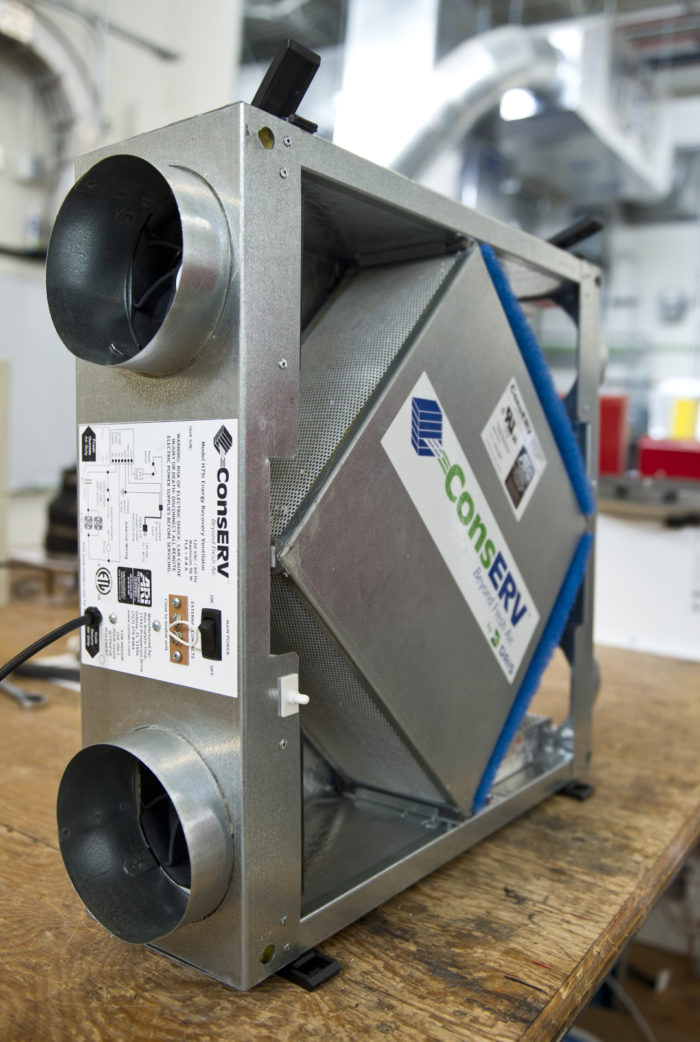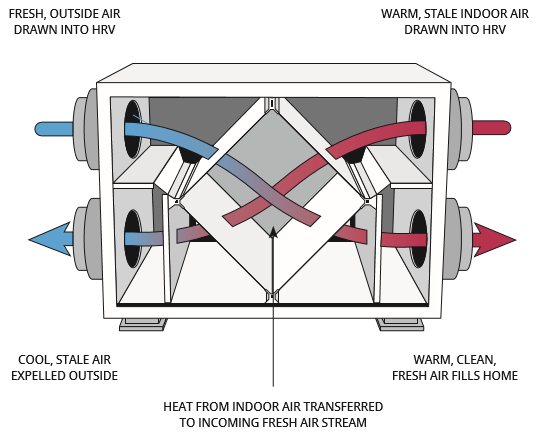HRV vs Other Ventilation Systems: What Homeowners Should Know
Wiki Article
Unveiling the Secret Benefits and Uses of Heat Recovery Ventilation in Lasting Design
Heat Recovery Ventilation (HRV) systems play a necessary role in lasting style. They facilitate a continual exchange of stagnant indoor air with fresh outside air, significantly boosting indoor air high quality. HRVs contribute to energy effectiveness by recovering warmth from exhausted air, which can lower energy prices. Recognizing the diverse benefits and applications of HRVs discloses their relevance in modern-day style. What various other advantages do these systems supply in the search of sustainability?Recognizing Heat Recovery Ventilation Solutions
Heat recovery ventilation (HRV) systems are created to improve indoor air quality while reducing energy loss. These systems utilize a mechanical air flow strategy to exchange stagnant interior air with fresh exterior air, guaranteeing a continual supply of tidy air. By capturing heat from the exhaust air, HRVs precondition incoming air, decreasing the need on home heating and cooling down systems. This process not only boosts thermal comfort yet additionally adds to energy effectiveness in property and business structures. Furthermore, HRV systems assist regulate moisture levels and decrease interior contaminants, promoting a healthier living atmosphere. Their tactical implementation is essential for achieving lasting layout goals, as they offer an equilibrium in between power preservation and resident health.How HRV Systems Job
While lots of may be acquainted with ventilation systems, understanding just how warm recovery ventilation (HRV) systems operate is important for valuing their benefits. HRV systems work by exchanging stagnant interior air with fresh outdoor air while transferring warmth between the 2 streams. This process takes place in a warm exchanger, where warmth from the outgoing air warms up the incoming air during colder months, lessening power loss. On the other hand, in warmer months, the system can cool inbound air using the cooler outgoing air. HRVs are outfitted with fans to assist in airflow and filters to get rid of particulates, making sure a constant, well balanced ventilation process. This cutting-edge layout not only improves power performance however additionally adds to keeping a comfortable indoor setting.Enhancing Indoor Air Top Quality
Interior air quality can significantly affect health and wellness and wellness, making reliable ventilation vital in contemporary homes. Heat Recovery Ventilation (HRV) systems play an essential role in maintaining interior air top quality by continually trading stagnant interior air with fresh exterior air. This procedure not just lowers air-borne toxins yet additionally lessens moisture degrees, which can bring about mold development and respiratory issues. HRV systems filter incoming air, removing irritants and particulates, therefore providing a healthier living atmosphere. Furthermore, these systems aid eliminate odors and unpredictable natural substances (VOCs) frequently discovered in family items. By ensuring a regular circulation of tidy air, HRV systems add to a general enhanced indoor ambience, promoting comfort and health for owners.Energy Efficiency and Expense Financial Savings
Power effectiveness sticks out as a significant advantage of Heat Recovery Ventilation (HRV) systems. By recording and recycling the warmth from worn down indoor air, HRVs minimize the energy needed for home heating inbound fresh air, causing lowered energy intake. This performance converts right into reduced energy expenses, providing substantial price savings for house owners and services alike. Furthermore, HRV systems typically receive power efficiency motivations and refunds, even more enhancing their monetary allure. In time, the first financial investment in HRV technology can bring about a beneficial roi with decreased energy expenditures. Consequently, the combination of HRV systems not just promotes sustainable layout but likewise gives a functional service for accomplishing long-term energy financial savings and financial benefits.Ecological Benefits of HRV

A plethora of ecological benefits develops from the application of Heat Recovery Ventilation (HRV) systems. By successfully transferring warmth from exhaust air to incoming fresh air, HRVs substantially decrease the power needed for home heating and cooling areas. This energy efficiency translates to lower greenhouse gas emissions, contributing to a decrease in the total carbon impact of structures. Furthermore, HRV systems enhance interior air high quality by constantly distributing fresh air, consequently lowering the focus of interior pollutants and allergens. Furthermore, the reduction in power usage aids in saving natural deposits, making HRVs a necessary part of lasting style. In general, the environmental benefits of HRVs play an important function in promoting a much healthier earth and promoting green building practices.
Versatile Applications in Modern Style
Heat recovery ventilation (HRV) systems are increasingly being incorporated right into both household and industrial building jobs. In residential setups, HRVs enhance interior air high quality while optimizing energy performance. On the other hand, in commercial rooms, these systems maximize ventilation techniques, demonstrating their convenience in modern-day building applications.Residential Projects Combination
While modern design significantly highlights sustainability, the integration of warmth recovery ventilation systems in household jobs has actually arised as a useful option for enhancing interior air top quality and energy performance. These systems effectively transfer warmth from exhaust air to incoming fresh air, decreasing energy loss and lowering heating or cooling demands. In new builds and retrofits alike, warmth recuperation air flow can be seamlessly incorporated, providing house owners with a much healthier living setting while decreasing energy expenses. Additionally, with boosting recognition of environmental influences, even more engineers and contractors are recognizing the long-term benefits of these systems. Therefore, warmth recuperation air flow has actually ended up being a vital element of sustainable domestic style, showcasing adaptability and dedication to environment-friendly techniques.Industrial Areas Optimization
As contemporary industrial spaces progress to fulfill the demands of sustainability and effectiveness, the implementation of heat recovery air flow systems arises as an essential technique for optimizing indoor environments. These systems assist in the exchange of stagnant indoor air with fresh outside air while reclaiming heat energy, significantly minimizing power usage. This not just improves convenience for owners but likewise assists in decreasing functional costs. Functional applications can be observed in workplaces, retail spaces, and instructional organizations, where air quality and temperature level control are vital. Furthermore, integrating warmth recuperation ventilation aligns with eco-friendly building accreditations, even more advertising environmental duty. Ultimately, taking on such systems in commercial style not only adds to sustainability goals however also cultivates much healthier, more effective spaces for individuals.
Integrating HRV Into Sustainable Layout Practices
Integrating heat healing air flow (HRV) systems right into lasting layout methods supplies significant benefits in power efficiency and indoor air quality. By utilizing HRV, designers can develop cost-effective solutions that not just lower power intake however likewise enhance the general comfort of indoor settings. This placement with sustainability objectives placements HRV as an essential component in modern architectural strategies.
Power Effectiveness Enhancement
By including heat recovery air flow (HRV) systems into lasting style practices, engineers and building contractors can significantly enhance power performance in modern-day constructions. HRV systems work by recording warmth from outward bound stale air and moving it to incoming fresh air, reducing the power required for home heating or cooling indoor rooms. This process not just decreases dependence on conventional heating and cooling systems yet likewise decreases overall power intake. Furthermore, HRV systems can aid preserve a regular indoor temperature level, reducing peak power demands. By incorporating these systems, buildings can attain considerable decreases in utility prices and carbon footprints, straightening with sustainability goals. Inevitably, HRV innovation stands for a practical option for boosting energy efficiency in the constructed atmosphere, advertising even more liable resource use.Indoor Air Top Quality Improvement
Exactly how can heat healing air flow (HRV) systems add to superior indoor air high quality in modern buildings? HRV systems successfully exchange stale interior air with fresh outdoor air while recuperating warmth energy, decreasing temperature variations. This process lowers the concentration of interior pollutants, such as volatile organic compounds (VOCs), allergens, and wetness, which can degrade air top quality and influence owner health. By maintaining perfect humidity levels and guaranteeing a constant supply of clean air, HRVs help create a healthier indoor environment. In addition, these systems can be integrated into lasting layout methods, promoting energy efficiency together with improved air quality. HRV Heat Recovery Ventilation. HRV modern technology plays a vital duty in progressing total owner convenience and wellness in contemporary building styles.Affordable Design Solutions

Regularly Asked Questions
What Upkeep Is Needed for Heat Recovery Ventilation Solutions?

Upkeep for heat recuperation ventilation systems usually entails routine filter substitutes, cleaning of warmth exchangers, examination of fans and air ducts, and guaranteeing appropriate water drainage. These tasks assist keep efficiency and prolong the system's life-span gradually.
Can HRV Equipments Be Set Up in Existing Buildings?
Heat recovery ventilation systems can without a doubt be installed in existing buildings. HRV Heat Recovery Ventilation. Retrofitting requires cautious planning and assessment of the structure's format, ensuring compatibility with current systems while maximizing energy effectiveness and interior air top qualityJust How Do HRV Equipment Influence Noise Degrees Inside Your Home?
HRV systems can affect interior sound levels by introducing sound from outside sources through air flow. Nonetheless, top notch setups typically integrate sound-dampening features, minimizing sound effect while supplying efficient air exchange and maintaining convenience inside.Are There Any Kind Of Drawbacks to Using HRV Systems?
The disadvantages of utilizing HRV systems include prospective high initial prices, maintenance obstacles, and the opportunity of decreased interior air quality if filters are sporadically changed, which can cause issues with humidity degrees.How Do I Select the Right HRV System for My Requirements?
Picking the best warm recovery ventilation system entails evaluating certain demands, such as building size, environment, and energy effectiveness objectives. In addition, assessing system features, setup requirements, and upkeep factors to consider is necessary for peak performance and complete satisfaction.Report this wiki page